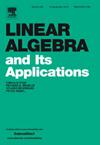Universal winners in trees
IF 1.1
3区 数学
Q1 MATHEMATICS
引用次数: 0
Abstract
Let be nonnegative, irreducible and , where is the i-th standard basis vector. For a fixed , an index is called a winner for the value if the spectral radius . If p remains a winner for each , then it is called a universal winner. The concepts have been introduced in 1996 and studied in only a few articles till now. When G is a simple connected graph (or a strongly connected digraph), the nonnegative weighted adjacency matrix being irreducible, one can talk of a universal winner vertex with respect to . The universal winners seem to capture the graph structures well. It is known that the only connected digraph G in which all vertices are universal winners with respect to all nonnegative weighted , is the directed cycle, thereby characterizing it. Let be nonempty. In a recent article, the class of directed connected graphs with vertex set , for which only the vertices in U are the universal winners with respect to all nonnegative weighted was characterized, generalizing the earlier result. Many other combinatorial results exploiting the graph structure were proved establishing the importance of the study of universal winner vertices. In this article, we further the study for the class of undirected graphs, in particular for trees, with respect to only the adjacency matrix. As expected, we show that there are trees in which no universal winner exists. More interestingly, every tree is a subtree of a tree with a unique universal winner and also a subtree of a tree without a universal winner. Trees with exactly universal winners are not easy to find. A construction of a class of trees with exactly k universal winners is provided. Interestingly, it turns out that for any undirected connected graph G, the set of winners of G and the corona are the same, where the later is obtained by adding a new pendent vertex to each vertex of G. It is also shown that if , then no vertex of degree one or two can be a universal winner. Previously, it was known that for a path P, the central vertices are the universal winners and as a vertex u goes farther from the center, the spectral radius decreases. We prove that a similar statement also holds for a grid graph.
树木的普遍赢家
设A∈Mn是非负的,不可约的,Eii= eiit,其中ei为第i个标准基向量。对于固定的t0>;0,如果谱半径ρ(a +t0Epp)=maxi∈[n]∈ρ(a +t0Eii),则指标p∈[n]:={1,2,…,n}称为值t0的赢家。如果p对于每个t>;0都是赢家,那么它被称为普遍赢家。这些概念早在1996年就被引入,但迄今为止只有几篇文章对其进行了研究。当G是一个简单连通图(或强连通有向图),非负加权邻接矩阵a (G)不可约时,可以讨论关于a (G)的一个普遍赢家顶点。通用赢家似乎很好地捕捉到了图形结构。已知唯一一个所有顶点相对于所有非负加权A(G)都是普遍赢家的连通有向图G是有向环,从而表征了它。设U∧[n]是非空的。在最近的一篇文章中,对一类顶点集[n]的有向连通图进行了刻画,其中只有U中的顶点是所有非负加权a (G)的普遍赢家,推广了先前的结果。利用图结构证明了许多其他的组合结果,从而建立了研究普遍赢家顶点的重要性。在这篇文章中,我们进一步研究了一类无向图,特别是树,仅关于邻接矩阵。正如预期的那样,我们证明了存在不存在普遍赢家的树。更有趣的是,每棵树都是一棵有唯一普遍赢家的树的子树,也是一棵没有普遍赢家的树的子树。完全具有1个普遍优胜者的树并不容易找到。给出了一类具有恰好k个全称胜利者的树的构造。有趣的是,对于任何无向连通图G, G和冕G°K1的胜者集合是相同的,其中后者是通过在G的每个顶点上添加一个新的垂顶点而得到的。还表明,如果ρ(a (G))>2,则没有一个或两个阶的顶点可以是普遍胜者。以前,已知对于路径P,中心顶点是普遍赢家,并且随着顶点u远离中心,谱半径ρ(a (P)+tEuu)减小。我们证明了一个类似的命题也适用于网格图。
本文章由计算机程序翻译,如有差异,请以英文原文为准。
求助全文
约1分钟内获得全文
求助全文
来源期刊
CiteScore
2.20
自引率
9.10%
发文量
333
审稿时长
13.8 months
期刊介绍:
Linear Algebra and its Applications publishes articles that contribute new information or new insights to matrix theory and finite dimensional linear algebra in their algebraic, arithmetic, combinatorial, geometric, or numerical aspects. It also publishes articles that give significant applications of matrix theory or linear algebra to other branches of mathematics and to other sciences. Articles that provide new information or perspectives on the historical development of matrix theory and linear algebra are also welcome. Expository articles which can serve as an introduction to a subject for workers in related areas and which bring one to the frontiers of research are encouraged. Reviews of books are published occasionally as are conference reports that provide an historical record of major meetings on matrix theory and linear algebra.

 求助内容:
求助内容: 应助结果提醒方式:
应助结果提醒方式:


